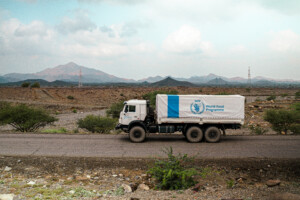Sudan OCHA bulletin 6: Jebel Marra displaced receive initial aid
The UN Office for the Coordination of Humanitarian Affairs (OCHA) in Sudan reports in its latest weekly bulletin that the fighting between government security forces and the Sudan Liberation Movement led by Abdelwahid El Nur (SLM-AW) in Darfur’s Jebel Marra continues to affect and displace more civilians, according to humanitarian organisations.
The UN Office for the Coordination of Humanitarian Affairs (OCHA) in Sudan reports in its latest weekly bulletin that the fighting between government security forces and the Sudan Liberation Movement led by Abdelwahid El Nur (SLM-AW) in Darfur's Jebel Marra continues to affect and displace more civilians, according to humanitarian organisations.
By 7 February, about 37,000 newly displaced people sought shelter in North Darfur. Aid organisations visited Sortony on 2-4 February and found 21,690 displaced at the Unamid team site in the area. These people, of whom 90 percent are women and children, have arrived from 59 villages. More people are reportedly on their way to Sortony. Others sought shelter in Kabkabiya town.
Along with assessing the needs, Unamid, Unicef, and the government’s Water and Environmental Sanitation Department (WES) distributed initial assistance to the displaced.
On 6 February, a second convoy with additional assistance for the displaced in Sortony was dispatched from El Fasher. The convoy will deliver food for 16,000 people for two months, as well as nutritional supplies for 3,800 children under the age of five and pregnant and nursing women for 15 days. It also includes a full set of emergency households items for 4,500 families (estimated 22,500 people), as well as medical, hygiene and other supplies.
In Tawila, the reported number of new displaced reached about 14,000 people. Aid organisations and the Darfur Regional Authority (DRA) continue to provide the people with food, nutrition, emergency household supplies as well as health, water, sanitation and education assistance. So far, at least 10,000 people have received some form of initial assistance, mainly food.
In Kabkabiya, 1,186 newly displaced are staying with relatives or the host community, the bulletin reads. The UN World Food Programme (WFP) planned to carry out a rapid food security assessment of this group on 7 February.
 Challenges of verifying new displaced in Central Darfur
Challenges of verifying new displaced in Central Darfur
National and international humanitarian organisations are currently not able to carry out any verification or assessment of newly displaced people who arrived in Central Darfur from Jebel Marra.
Local authorities stated that they are taking full responsibility on this matter and will provide any assistance required. However, humanitarian organisations are concerned about whether all displaced and other conflict-affected people are able to receive the assistance they need. However, significant movement restrictions and the volatile security situation prevent aid organisations from ascertaining that.
According to the Humanitarian Aid Commission (HAC) in Central Darfur, the reported number of new displaced in Guldo, Tur, and Daya are still 415, 660, and 2,190 respectively. These figures are not confirmed, and are very likely to change after registration and verification.
Local authorities provided food supplies and 3,000 blankets to the new displaced in Tur and surrounding areas.
International aid agencies unable to assist displaced in West Darfur
International aid organisations have been unable to access, assess needs or assist an estimated 5,000 people from Mouli and surrounding villages who fled to El Geneina, capital of West Darfur in early January.
These people fled the villages of Muoui, Atia, Fangata, Tandikoro, and Jeta following inter-communal violence in the area. Some sources also report that an unknown number of people have fled to neighbouring Chad.
According to the HAC, on 1 February the Darfur Regional Authority sent relief supplies to the five affected villages. This is the third shipment of relief supplies provided by the government and national charity organisations to the villagers, HAC stated. The first shipment of relief supplies was provided by local organisations and traders, according to the HAC. On 26 January, the National NGOs Network, the Women’s Union, and civil society organisations reportedly sent a second shipment of relief supplies including unspecified amounts of food and emergency household supplies to the affected villagers.
Joint assessment mission to Niteaga in South Darfur
On 3 February, an inter-agency mission identified that an estimated 2,900 displaced in Sheigei and Kabgay villages in South Darfur’s Niteaga locality, were in need food, emergency household supplies, water, sanitation, education and health assistance. These people fled their homes in Obeid village in Bielel locality mid-December 2015.
Mid-January aid organisations were requested by HAC to assist them to return home. The provision of assistance will be dispatched in the coming weeks.
Almost 200,000 South Sudanese in Sudan
As of 1 February, the number of South Sudanese refugees who arrived in Sudan has reached 199,608, of whom 129,135 refugees received some form of humanitarian assistance, according to the UNHCR.
In January, 5,204 South Sudanese refugees arrived in Sudan, which is higher than the average arrival rate of 3,514 over the past five months.
UNHCR’s biometric registration is ongoing in the White Nile State and is expected to be finalised by the end of February. To date, five sites have been completed and registration is taking place in the last two sites of El Redis II and Um Sangor.
Read the full OCHA bulletin here











 and then
and then